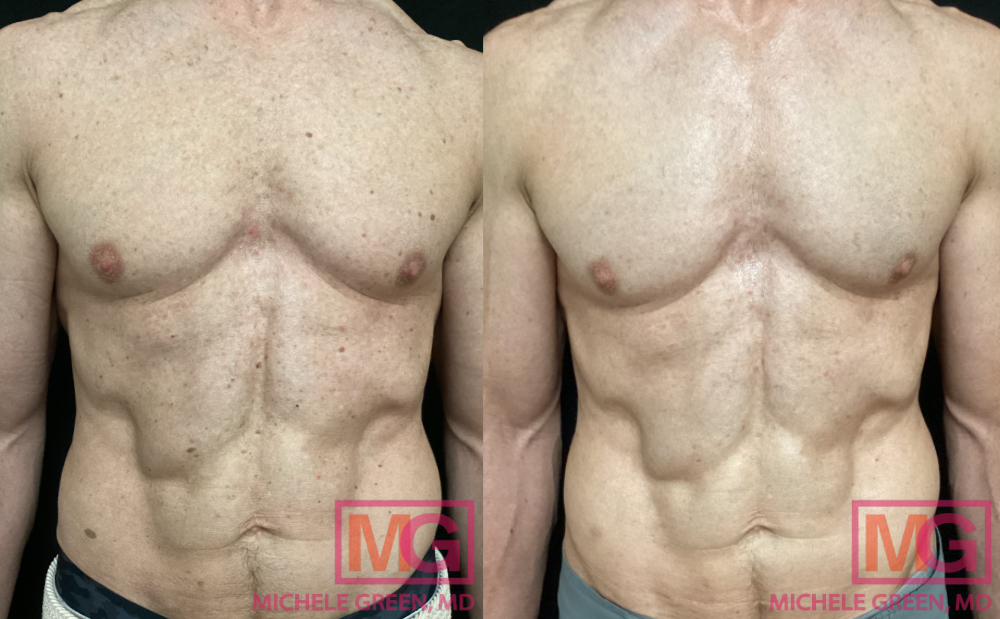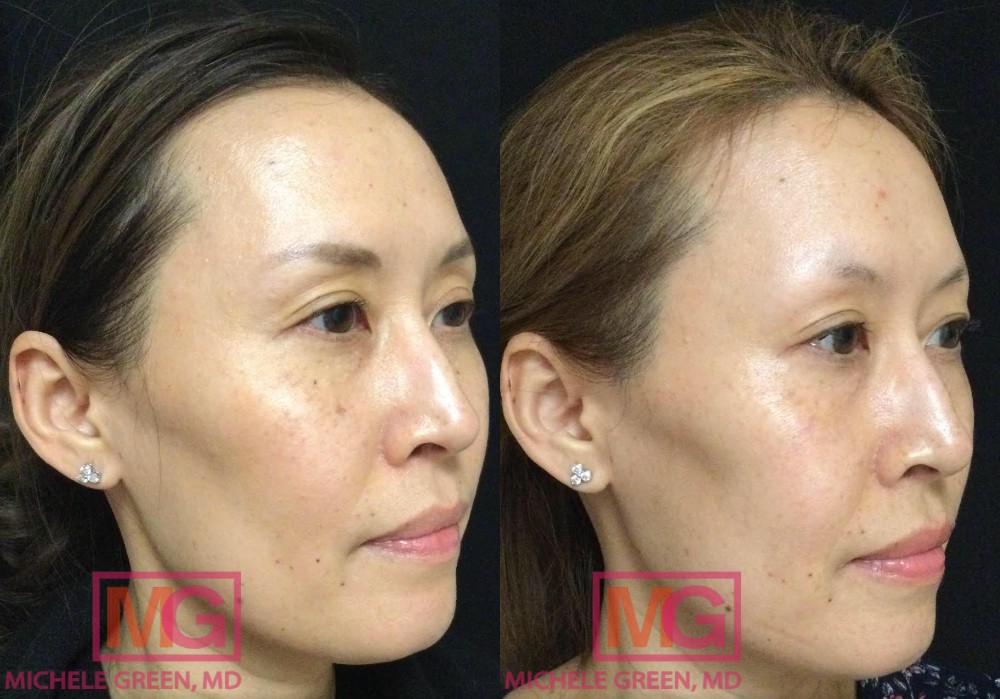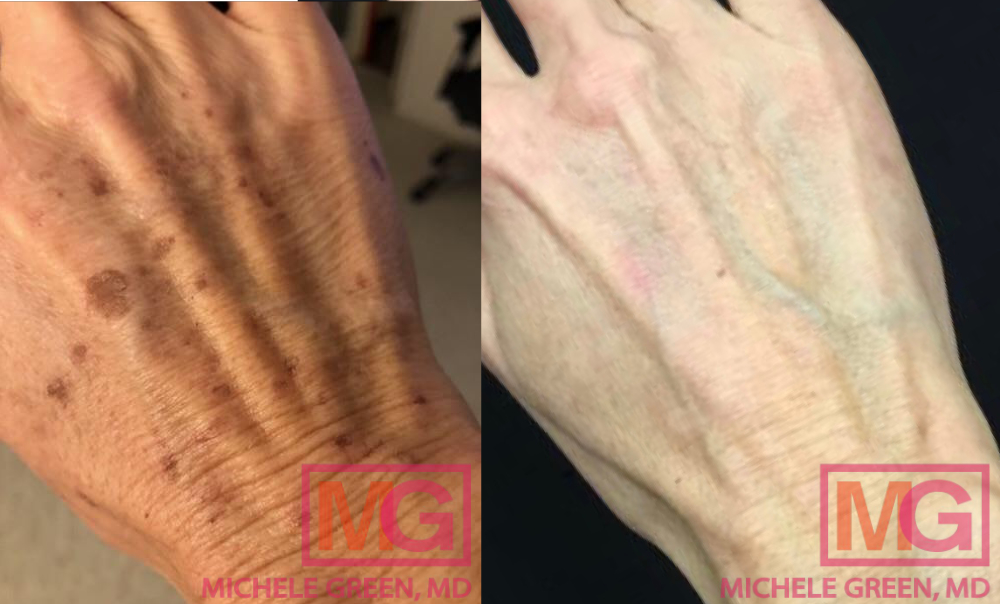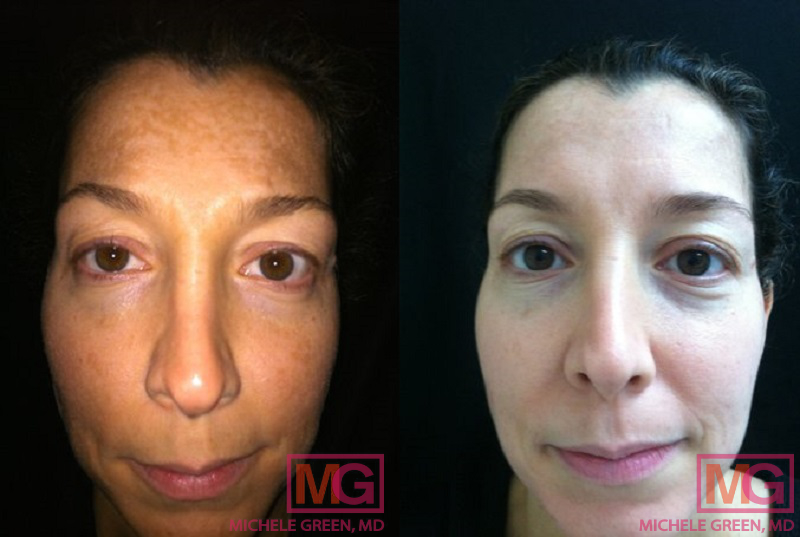Are Sunspots Permanent?
As we age, dark spots can appear on the face due to excess melanin production, which may result from scarring, inflammation, untreated acne, skin conditions like melasma, or unprotected sun exposure. One of the most common types of dark spots is sunspots—also known as age spots, solar lesions, or liver spots—which are a form of hyperpigmentation characterized by flat, brown spots that usually develop on areas most exposed to the sun, such as the face, hands, arms, and shoulders. These spots are most common in people over 40. Unlike precancerous lesions, dark spots are harmless. However, they can be distressing signs of aging that make patients feel self-conscious, especially when hyperpigmentation appears on highly visible areas, such as the face, arms, chest, and hands. Fortunately, many treatment options are available at Dr. Michele Green’s New York City dermatology practice to lighten the skin, promote a more even tone, and reduce signs of sun damage.
Unlike freckles that fade over time, age spots caused by excessive sun exposure will not disappear on their own. Therefore, it is crucial to consult a board-certified dermatologist, such as Dr. Green, who can provide a variety of skin lightening treatments to rejuvenate the skin and diminish sunspots on the face. Several laser therapies are highly effective at removing hyperpigmentation, including the Candela Alex-Trivantage laser, the Clear + Brilliant laser, and the Fraxel laser. Each laser treatment works differently to break down the excess melanin responsible for dark spots. In addition to laser procedures, Dr. Green offers various chemical peels, like the Cosmelan peel and mesopeels, to exfoliate the skin and encourage the growth of new skin cells for a brighter, more revitalized complexion. Microneedling, microdermabrasion, and hydrofacials effectively resurface the skin and stimulate collagen production, resulting in a clearer and more youthful appearance. Dr. Green also offers a wide selection of skincare products through her proprietary MGSKINLABs to cleanse, exfoliate, hydrate, and brighten the skin.
With many options available to remove sunspots on the face, it is best to consult an experienced, board-certified dermatologist like Dr. Green. She has been treating patients and promoting wellness at her Upper East Side, New York City dermatology practice for over 25 years. An expert in various cosmetic and medical treatments—including laser therapies, chemical peels, dermal fillers, Botox, and more—Dr. Green offers a wide range of solutions suitable for all skin types and tones. Known for high patient satisfaction, she has been named one of the best dermatologists in New York City by publications such as Castle Connolly, Super Doctors, and New York Magazine.
What are sunspots?
Sunspots are areas of hyperpigmentation characterized by small, brown, or gray spots on the skin’s surface. These spots can range in size from a tiny freckle to as large as half an inch in diameter. Often called liver spots, solar lentigines, or age spots, they usually form due to unprotected exposure to harmful UV rays and are most commonly found on the face, hands, arms, and neck. Sunspots typically develop over time, often appearing during middle age (40s-50s) as a result of sun damage sustained in youth. When UV rays from the sun or tanning beds penetrate unprotected skin, they stimulate the production of melanin, the pigment that helps shield the skin from damage. However, this increased melanin can lead to dark spots or patches of hyperpigmentation, resulting in a spotty or uneven skin appearance.
How are sunspots formed?
Patients often wonder, “How are sunspots formed on the skin?” Sunspots usually appear on areas that have been most exposed to the sun. When skin is overexposed to sunlight, the body produces more of the natural pigment melanin to protect the skin from harmful ultraviolet light, also known as UV rays. Melanin is produced in the body by melanocytes, which are cells located in the epidermal layer of the skin. The amount of melanin in the skin is directly related to skin color. People with darker skin naturally have more melanin than those with lighter skin. Melanin helps protect the body’s DNA from UV rays and also offers protection against skin cancers, such as melanoma. Overexposure to harmful UV rays, whether from sun exposure or tanning beds, causes melanocytes to produce excess melanin, resulting in hyperpigmentation. This hyperpigmentation, or buildup of melanin, is what causes age spots to develop.
Does sun damage lead to the appearance of sunspots?
Sunspots are very common, particularly among individuals over 40 years old. However, certain risk factors can increase your chances of developing sunspots over time. Sunspots form as a result of sun damage, and therefore, people who have had intense or frequent exposure to the sun or tanning beds without sun protection are more likely to develop brown spots on exposed areas. Additionally, individuals with a history of severe sunburns are more prone to having these dark spots appear on their skin. Another risk factor is skin type or skin tone. Individuals with lighter skin typically have less melanin, making them more prone to developing this skin discoloration. However, people with darker skin tones are also vulnerable to sun exposure and can suffer from sun spots and facial melasma.
When to see a dermatologist for sunspots
When new or changing dark spots appear on the face or body, it is advisable to schedule an appointment with a board-certified dermatologist, such as Dr. Michele Green, to determine if the dark spot may signal an underlying health issue. Sunspots are harmless and do not suggest skin cancer. However, some patients may feel self-conscious about the appearance of age spots on visible areas, such as the face, chest, and hands. In such cases, Dr. Green can suggest the best treatment options for your specific needs, whether that involves topical treatments or in-office procedures like laser therapy, chemical peels, or microdermabrasion.
How are sunspots removed?
At Dr. Green’s Upper East Side, New York City dermatology office, numerous treatment options are available for removing sunspots. Dr. Green begins the treatment by examining the affected area and discussing your goals. Depending on the size, location, and the patient’s skin tone, Dr. Green creates a treatment plan with safe and effective options. Some patients may benefit most from laser treatment, with Dr. Green often using the Candela Alex-Trivantage laser, Fraxel laser resurfacing, or Intense Pulsed Light (IPL) for sunspots. In other cases, Dr. Green opts for chemical peels, which enhance skin cell turnover for smoother, brighter skin. Patients can also lighten dark spots at home using topical treatments like Vitamin C, retinoids, and exfoliants such as kojic acid, azelaic acid, and glycolic acid. To avoid irritation, be sure to follow Dr. Green’s instructions for the proper application of these topical treatments.
Laser treatment for sunspot removal
Candela Alex-Trivantage Laser
The Candela Alex-Trivantage laser is one of the most popular treatments at Dr. Green’s office for removing sun spots. The treatment works by emitting wavelengths of light that directly target pigmentation. The light is absorbed into the brown, melanin-rich spots, where it is then converted into heat, destroying the melanin. The micro-injury to the skin also stimulates collagen production, leading to the formation of lighter new skin cells. Because the laser specifically targets melanin, this treatment is safest for patients with lighter skin tones. Dr. Green usually recommends one or two sessions of the Candela Alex-Trivantage laser to achieve optimal results. The recovery time is minimal—typically, a small scab will form over the sunspot while the surrounding skin remains unaffected. About a week after treatment, the scab will heal, and the hyperpigmentation will begin to fade.
Intense Pulsed Light (IPL)
Intense Pulsed Light (IPL) treatment, also called a “Photofacial,” is an effective way to address various types of hyperpigmentation, including sun spots and redness, as well as fine lines, and to enhance skin texture. The treatment works by emitting multiple wavelengths of light that penetrate to the skin’s dermal layer, where they are absorbed by melanin-rich cells that form sunspots. These cells convert the light energy into heat, which destroys the pigmentation. Unlike other laser treatments, such as the Candela Alex-Trivantage laser, IPL uses several wavelengths of light instead of just one to treat skin issues. The procedure is safe and effective, with minimal discomfort. Most patients describe the sensation as feeling like a light snap of a rubber band on the face. After the treatment, there is no downtime or recovery period, allowing patients to resume their normal activities immediately.

Fraxel Laser Resurfacing
The Fraxel laser is a treatment option specifically approved for addressing sun damage, age spots, fine lines, acne scars, and restoring a smooth skin texture. The laser uses two wavelengths, 1927 and 1550, to resurface a targeted area while leaving the surrounding skin unaffected. The two wavelengths target different skin conditions, with 1927 primarily used for hyperpigmentation and 1550 for fine lines, acne scars, and improving skin texture. When used together, the two wavelengths of the Fraxel laser can promote a full facial rejuvenation—reducing brown spots and eliminating fine lines and creases for a lighter, brighter, more youthful appearance.
Because of the fractional effects of the laser, there is very little downtime, and healing occurs much faster. Patients can usually resume their normal activities immediately after the treatment. Dr. Green recommends three sessions, spaced four to six weeks apart, for the best results. Fraxel lasers are generally considered the safest choice for patients with light skin tones. Patients with darker skin tones can achieve a similar effect with the Clear + Brilliant laser.
Clear + Brilliant Laser Treatment
The Clear + Brilliant laser, often called the “Mini-Fraxel laser,” is an FDA-approved skin resurfacing treatment that is gentle and safe for all skin types. The laser uses fractionated technology to create tiny injuries on the skin’s surface, which triggers the body’s natural healing process and boosts collagen and new skin cell production. As a result, the skin looks lighter and brighter, giving a more youthful and refreshed appearance. The treatment effectively targets sun damage, age spots, improves skin tone and texture, and reduces fine lines. Dr. Green recommends scheduling five treatments for optimal results, spaced about a month apart. Since the procedure is gentle, there is no downtime, and patients can return to their normal activities immediately.
Skin treatments for removing sunspots
Topical treatments such as creams, lotions, and exfoliating solutions are effective options for fading dark spots. Dr. Green can recommend skincare products that are available both over-the-counter (OTC) and by prescription.
Retinoids
Retinol creams and topical retinoids can effectively remove sunspots and discoloration on the skin’s surface. The treatment exfoliates to eliminate dead skin cells and stimulate collagen production for total skin rejuvenation. Many topical retinoids are available, but to find the most effective product, it is best to consult with Dr. Green and order from MGSKINLABs.
Vitamin C
Vitamin C is an antioxidant that helps protect the skin from free radical damage and reduces the appearance of pigmentation and dark spots. When applied to the skin’s surface, it can help lessen signs of aging by reducing collagen breakdown and reversing UV damage. Dr. Green offers her proprietary line of skincare products, MGSKINLABs, and her Vitamin C serum is one of the most popular items sold. Topical vitamin C serums can be added to a patient’s skincare routine to lighten dark spots and defend the skin against free radicals.
Azelaic Acid
Azelaic acid is a highly effective ingredient for reducing the appearance of dark spots. Found in many over-the-counter anti-aging or acne reduction products, azelaic acid helps boost skin cell turnover and brighten the skin. In higher concentrations, azelaic acid effectively fades dark spots by inhibiting the enzyme tyrosinase, which triggers melanin production in melanocytes. When used regularly on the treatment area, azelaic acid is very effective at diminishing dark spots and can be used alone or alongside other treatments.
Kojic Acid
Topical treatments containing kojic acid can help diminish the appearance of sunspots by blocking melanin production at the cellular level. Similar to azelaic acid, kojic acid functions as a tyrosinase inhibitor, preventing the enzyme from triggering melanin formation. When used regularly, kojic acid reduces skin pigmentation, lightening dark spots over time.
Hydroquinone
Dr. Green might recommend a topical skin lightening cream that contains the powerful ingredient hydroquinone, which works to block melanin production and the movement of melanin in the dermis. Hydroquinone can cause significant side effects and may irritate the skin, especially for patients with darker skin tones or sensitive skin. For these patients, Dr. Green might suggest a hydroquinone-free brightening cream containing tranexamic acid instead of hydroquinone. The tranexamic acid-based cream works similarly to inhibit melanin production but is generally gentler on the skin.
Exfoliating Skincare
Exfoliating the skin should be done one to two times a week to help remove dead skin cells from the face, promoting skin cell renewal and unclogging pores. There are two types of exfoliation: chemical and physical. Chemical exfoliation involves applying a solution with key ingredients such as lactic acid, salicylic acid, kojic acid, or glycolic acid, which react with dead skin cells and debris, causing them to slough off. This process encourages new collagen production, leaving the skin bright and clear. Physical exfoliation involves using an abrasive ingredient like biodegradable beads or sugar. While physical exfoliation is very effective, it can also cause skin irritation, so consult your dermatologist to determine which method is best for you, especially if you have sensitive skin. The most effective ingredients for targeting dark spots include kojic acid, azelaic acid, and glycolic acid.

Eliminating sunspots with chemical peels
Chemical peels are an effective treatment for various conditions, including the removal of sun spots and other types of hyperpigmentation, the treatment of melasma, and the reduction of fine lines, wrinkles, and acne scars. Different types of chemical peels vary in depth and strength, as well as in the types of exfoliating acids used, like glycolic acid, salicylic acid, and azelaic acid. There are three levels of chemical peels: light, medium, and deep. Usually, Dr. Green recommends light or medium peels to treat sun spots, while deep peels are reserved for severe wrinkles or certain skin cancers. A chemical peel works by the acid reacting with dead skin cells, debris, and dirt on the skin’s surface. This reaction exfoliates the skin, unclogs pores, removes dead cells, and stimulates the growth of new, lighter skin. At Dr. Green’s office, the most popular chemical peels for addressing sun spots are the Mesopeels and Cosmelan peels.
A trichloroacetic acid (TCA) peel is a medium-depth chemical treatment that exfoliates both the outer skin layer and the underlying layers to promote facial rejuvenation. TCA peels effectively improve skin tone and texture, addressing issues such as hyperpigmentation, sun spots, acne scars, active acne, enlarged pores, fine lines, and other signs of aging. However, they are not recommended for patients with darker skin tones, as there is a higher risk of hypopigmentation, post-peel discoloration, and hyperpigmentation. Different strengths of TCA peels can be used depending on the patient’s skin type and tone. Typically, multiple sessions are necessary to achieve optimal results. While TCA peels are effective at removing sun spots, they are not suitable for darker skin tones due to the increased risk of post-peel hypopigmentation, discoloration, and hyperpigmentation.
A Mesopeel is a specially formulated chemical peel designed to diminish sun spots, melasma, and other forms of hyperpigmentation on the skin. Unlike other chemical peels, Mesopeels are gentle and safe for use on patients of all skin tones, including darker skin tones. Mesopeels contain skin-lightening agents such as azelaic acid, kojic acid, and tranexamic acid, which inhibit melanin production and regulate melanocytic activity. Patients typically undergo four to six treatment sessions for optimal results.
Can sunspots be permanently removed?
Patients often ask, “Can sunspots be removed permanently?” Several treatments, such as laser procedures, chemical peels, and topical medications, can remove existing sunspots permanently. However, these procedures do not stop new sunspots from developing. To prevent new sunspots, patients should follow strict sun protection measures to shield their skin from UVA and UVB rays. Dr. Green recommends applying sunscreen with an SPF of 30 each morning and reapplying it every 2 hours when outdoors. Patients should also wear protective clothing, including hats, long-sleeve shirts, and lightweight pants. Additionally, Dr. Green advises staying indoors or in the shade when the sun is most intense, between 10 am and 2 pm.
When do sunspots appear on the skin?
According to the Mayo Clinic, sunspots typically begin to appear in people during their 40s and 50s. However, extensive sun exposure can cause liver spots to develop in younger individuals as well. Generally, areas of pigmentation like freckles may begin to merge over time, creating speckled or mottled patches of hyperpigmentation on the skin. Sunspots can be prevented by using sunscreen and avoiding direct sunlight. It is important to start prevention strategies early in life to prevent sunspots from forming later.
Are sunspots harmful? Are sunspots a sign of skin cancer?
The development of dark spots on the skin’s surface can be just a cosmetic concern or potentially a sign of skin cancer. According to the Skin Cancer Foundation, 1 in 5 Americans will develop skin cancer by age 70. It’s very important to have any new, concerning dark spot checked by a dermatologist to make sure it’s not cancerous. Often, dermatologists can determine if a spot might be harmful simply by examining it. But some spots require a biopsy, where a dermatologist removes a small piece of the affected skin for further testing.
Different types of spots have different causes and features, allowing you to distinguish between hyperpigmentation, such as age spots, melasma, seborrheic keratoses, and skin cancer. Age spots, a type of hyperpigmentation, result from an overproduction of melanin in the skin, leading to discoloration on the surface. They typically appear as flat, brown, black, or gray spots and are often found on areas of the skin exposed to the sun frequently. Skin cancer, however, is caused by the uncontrolled growth of abnormal skin cells. The risk factors for skin cancer are similar to those for sunspots: exposure to harmful UV rays can lead to its development. Skin cancer may present as new, growing, or changing dark spots on the skin’s surface, often with irregular borders. If you notice a new or changing dark spot, Dr. Green recommends visiting her dermatology office to have it checked for skin cancer.
Do sunspots spread?
Liver spots develop from repeated or intense exposure to the sun’s ultraviolet rays. They occur due to increased melanin production, which gathers in one area, forming a tan or brown spot. Once formed, however, they usually don’t grow. If you notice a spot with irregular borders that is enlarging, shifting, darkening, or changing in color, it could be a sign of malignant melanoma or skin cancer. If you see changes in spots on your body, it’s best to see Dr. Green so she can determine whether they are harmless liver spots or potentially cancerous lesions.
Can sunspots peel off?
One common method for removing sunspots is cryotherapy, which involves applying liquid nitrogen to freeze the spot, causing it to peel away. Although often cited as an effective way to eliminate brown spots, the results can vary, and the procedure may cause discomfort and require recovery time. Many other options are more reliable and don’t need downtime, which is why Dr. Green usually opts not to use cryotherapy for sunspots.
Will sunspots ever go away?
Unlike freckles, which often fade over time, sunspots typically do not disappear on their own. They develop over time due to repeated exposure to the sun’s harmful UVA and UVB rays, which cause the skin to produce more melanin to protect itself from further damage. Therefore, without treatment from a dermatologist, sunspots will not fade naturally.
How long do sunspots last?
Unless they are treated, sunspots are permanent. While sunspots are not dangerous and do not pose a significant health risk, some patients find their appearance frustrating—especially since they do not fade away on their own. Fortunately, many treatment options are available at Dr. Green’s Upper East Side, New York City dermatology office to remove sunspots. After the treatments, sunspots are permanently eliminated, although these procedures do not prevent new sunspots from forming.

Are brown sunspots permanent?
Once dark spots appear on the face due to sun damage, scarring, post-inflammatory hyperpigmentation, or inflammation, they often do not fade on their own. However, when you seek treatment from a skilled dermatologist like Dr. Michele Green, you’ll be offered many safe and effective options to lighten dark spots. At Dr. Green’s office, she provides in-office treatments such as chemical peels, laser therapy, and microneedling, along with recommendations for skincare products that help correct dark spots. Typically, Dr. Green recommends formulations containing key ingredients such as kojic acid, vitamin C, vitamin E, arbutin, licorice root extract, and azelaic acid. To discover which products are best for you, schedule an initial consultation with Dr. Green.
How are sunspots caused?
Patients often wonder, “What are sunspots ultimately caused by?” Dark spots form on the skin’s surface due to repeated overexposure to the sun’s damaging UVA and UVB rays. Without proper sun protection, UV rays can damage the DNA in the skin, and the body responds by producing more melanin to prevent that damage. Melanin is a pigment that gives skin its color, created by cells called melanocytes. When skin is exposed to the sun without sunscreen or other protection, the enzyme tyrosinase stimulates melanocytes in the exposed area to multiply, increasing melanin production. This melanin absorbs UV rays to protect the skin; however, it also causes a dark spot to develop in that area. The number and size of sunspots depend on the amount of sun damage that has accumulated over a lifetime—the more frequent and intense the exposure, the deeper and more widespread the skin discoloration. Besides sun damage, factors such as scarring, inflammation, or skin conditions like melasma can also lead to certain types of hyperpigmentation.
How to permanently remove sunspots today
While days in the sun are enjoyable for most people, you must wear sunscreen and practice strict sun protection whenever you’re outside. Signs of sun damage, such as fine lines, wrinkles, sagging skin, broken capillaries on the nose, dark spots, precancerous lesions, and worsening melasma, often appear in patients in their 40s but result from sun damage that occurred during their youth. While the best way to prevent photoaging is to avoid sun damage initially, patients showing these signs can explore various treatment options, including laser therapy, chemical peels, topical solutions, dermal fillers, and microneedling. To find out which treatment is right for you, schedule an initial consultation with expert dermatologist Dr. Michele Green.
Dr. Michele Green is a globally recognized, board-certified dermatologist with over 25 years of experience offering her patients the best non-invasive treatment options. Dr. Green adopts a holistic approach, embracing a less-is-more philosophy, and designs personalized skincare routines and treatment plans that address her patients’ unique concerns and aesthetic goals. She is consistently recognized as one of New York’s top dermatologists by Castle Connolly, New York Magazine, and Super Doctors for her dedication and expertise. Call us at 212-535-3088 or email our New York City-based office today to schedule a consultation with Dr. Michele Green to develop your treatment plan for dark spots.
 212-535-3088
212-535-3088 